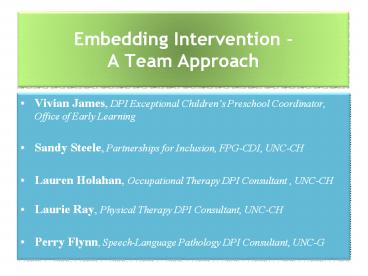Embedding Intervention - - PowerPoint PPT Presentation
1 / 20
Title:
Embedding Intervention -
Description:
Embedding Intervention - A Team Approach Vivian James, DPI Exceptional Children s Preschool Coordinator, Office of Early Learning Sandy Steele, Partnerships for ... – PowerPoint PPT presentation
Number of Views:395
Avg rating:3.0/5.0
Title: Embedding Intervention -
1
Embedding Intervention -
A Team Approach
- Vivian James, DPI Exceptional Childrens
Preschool Coordinator, Office of Early Learning - Sandy Steele, Partnerships for Inclusion,
FPG-CDI, UNC-CH - Lauren Holahan, Occupational Therapy DPI
Consultant , UNC-CH - Laurie Ray, Physical Therapy DPI Consultant,
UNC-CH - Perry Flynn, Speech-Language Pathology DPI
Consultant, UNC-G
2
Purpose
- Overview of a training module for teams of Speech
Language Pathologists, Occupational and Physical
Therapists, and Itinerant Preschool Exceptional
Children Teachers. - Introductory Level, 5 hour course
3
Objectives of Training Module
- Review models of service delivery
- Learn the what and why of embedding intervention
for specialists and teachers
2004, www.zerotothree.org
4
Objectives (continued)
Objectives, continued
- Acquire knowledge and skills needed to implement
embedded instruction - Practice method of embedding goals into the
activities and routines of the classroom - Discuss different data collection systems and
possible challenges - Examine strategies to embed intervention into
classroom activities and routines
5
Specialized Instruction
IEP
Targeted Curricula (e.g., CSEFEL, Early
Literacy)
Differentiated
Curriculum On-Going Assessment
Universal
North Carolina Early Learning Standards
and Infant Toddler Standards
Adapted from McClean, 2008
6
What We Know to be True
About Very Young Children
- A young childs performance can be affected by
his/her emotional state and the conditions of the
environment. - Young children perform best when they are
interested in what they are doing. - Early development is rapid, episodic and highly
influenced by experience. - A childs lack of experience doing a task does
not mean that the underlying ability is delayed.
7
Continuum of Service Delivery Models
Continuum of Service Delivery Models
- Individual pull-out
- Small group pull-out
- One-on-one in classroom
- Group activity in classroom
- Individual during classroom routines
- Consultation
- Adapted from Continuum of Six Consultative
Models, R.A. McWilliam, 1995
8
What it looks like - Video Clip 1
- Child Quran, Age 4, Autism
- Interventionist Speech-language
- Routine free play
- Goals shared attention, turn-taking,
- making choices
- Method individualized within routines
9
What is
Embedded Intervention?
Embedded interventions are teaching strategies
that address a specific learning goal within the
context of everyday activities, routines, and
transitions at home, at school, or in the
community. Terms such as routines-based
interventions, embedded instruction, or embedded
learning are used to mean the same thing.
CONNECT 2009 http//community.fpg.unc.edu/
10
DEFINITION Embedded Intervention
Basic Principles of
Embedded Intervention
- assumes collaborative planning
- occurs within daily routines
- uses childhood activity as instructional and
therapeutic media - works within dynamic system of child, activity,
and/or environment - - Adapted from Frank Porter Graham Child Care
Staff Dr. Robin McWilliam, 2005
11
Why embed intervention
into natural routines activities?
- Laws
- Research
- Benefits
- Families/Caregivers
12
Becoming an Embedded Practitioner
- Team approach
- Transdisciplinary approach
- Intentionally demonstrate to staff
- Adopt flexible scheduling practices
- Collaborative consultant
13
What it looks like Video Clip 3
- Child Perl, age 4, Cerebral Palsy
- Interventionist Special Education
- Routine Free play
- Goals Social interaction,
communication with peers - Method Individualized within routines
14
Embedding Individual Goals into Classroom
Routines Activities
15
Embedding Goals
into Daily Routines Activities
- Team approach
- Understanding of the relationship between
childhood standards, curricula, IEP/IFSP - IEP?IFSP with functional goals
- Daily schedule including planned activities
- Knowledge of childs preferences, interests,
motivators
16
Intervention Strategies
- Assistance
- Change in Expectations
- Delay
- Forgetfulness
- Novelty
- Piece by Piece
- Visible but Unreachable
- Responsive Teaching
- Pretti-Frontczak Bricker, 2004
- Wesley, Dennis, Tyndall, 2007
17
Guidance for Data Collection System
- Procedures are linked to criterion
- Procedures are flexible applicable across
settings, events, people - Procedures yield valid reliable data
- Responsibility is shared by team
- Procedures are compatible with resources
- Pretti-Frontczak Bricker, 2004
18
Classroom Data Collection Scoring System
- 1 Child completes goal independently
- 2 Child requires a verbal prompt
- 3 Child requires a verbal physical
- prompt
- 4 Child requires a verbal physical
- assistance
19
Embedded InterventionEXAMPLES
20
Embedded InterventionSystem

